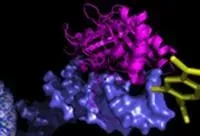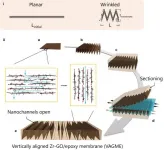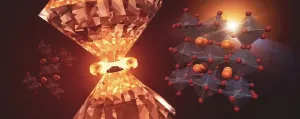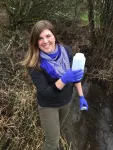INFORMATION:
The study was supported by the European Regional Development Fund, the Lisbon Portugal Regional Development Program, the Portuguese Foundation for Science and Technology, and the U.S. Department of Energy.
Written by David L. Chandler, MIT News Office
Paper: "Personal vehicle electrification and charging solutions for high-energy days."
https://www.nature.com/articles/s41560-020-00752-y
How to get more electric cars on the road
Study measures which kinds of infrastructure improvements could lead to wider adoption of clean vehicles
2021-01-21
(Press-News.org) A new study from researchers at MIT uncovers the kinds of infrastructure improvements that would make the biggest difference in increasing the number of electric cars on the road, a key step toward reducing greenhouse gas emissions from transportation.
The researchers found that installing charging stations on residential streets, rather than just in central locations such as shopping malls, could have an outsized benefit. They also found that adding on high-speed charging stations along highways and making supplementary vehicles more easily available to people who need to travel beyond the single-charge range of their electric vehicles could greatly increase the vehicle electrification potential.
The findings are reported today in the journal Nature Energy, in a paper by MIT associate professor of energy studies Jessika Trancik, graduate student Wei Wei, postdoc Sankaran Ramakrishnan, and former doctoral student Zachary Needell SM '15, PhD '18.
The researchers developed a new methodology to identify charging solutions that would conveniently fit into people's daily activities. They used data collected from GPS tracking devices in cars, as well as survey results about people's daily driving habits and needs, including detailed data from the Seattle area and more general data from the U.S. as a whole. Greatly increasing the penetration of electric cars into the personal vehicle fleet is a central feature of climate mitigation policies at local, state, and federal levels, Trancik says. A goal of this study was "to better understand how to make these plans for rapid vehicle electrification a reality," she adds.
In deciding how to prioritize different kinds of improvements in vehicle charging infrastructure, she says, "the approach that we took methodologically was to emphasize building a better understanding of people's detailed energy consuming behavior, throughout the day and year."
To do that, "we examine how different people are moving from location to location throughout the day, and where they are stopping," she says. "And from there we're able to look at when and where they would be able to charge without interrupting their daily travel activities."
The team looked at both regular daily activities and the variations that occur over the course of a year. "The longitudinal view is important for capturing the different kinds of trips that a driver makes over time, so that we can determine the kinds of charging infrastructure needed to support vehicle electrification," Wei says.
While the vast majority of people's daily driving needs can be met by the range provided by existing lower-cost electric cars, as Trancik and her colleagues have reported, there are typically a few times when people need to drive much farther. Or, they may need to make more short trips than usual in a day, with little time to stop and recharge. These "high-energy days," as the researchers call them, when drivers are consuming more than the usual amount of energy for their transportation needs, may only happen a handful of times per year, but they can be the deciding factor in people's decision making about whether to go electric.
Even though battery technology is steadily improving and extending the maximum range of electric cars, that alone will not be enough to meet all drivers' needs and achieve rapid emissions reductions. So, addressing the range issue through infrastructure is essential, Trancik says. The highest-capacity batteries tend to be the most expensive, and are not affordable to many, she points out, so getting infrastructure right is also important from an equity perspective.
Being strategic in placing infrastructure where it can be most convenient and effective -- and making drivers aware of it so they can easily envision where and when they will charge -- could make a huge difference, Trancik says.
"There are various ways to incentivize the expansion of such charging infrastructures," she says. "There's a role for policymakers at the federal level, for example, for incentives to encourage private sector competition in this space, and demonstration sites for testing out, through public-private partnerships, the rapid expansion of the charging infrastructure." State and local governments can also play an important part in driving innovation by businesses, she says, and a number of them have already signaled their support for vehicle electrification.
Providing easy access to alternative transportation for those high-energy days could also play a role, the study found. Vehicle companies may even find it advantageous to provide or partner with convenient rental services to help drive their electric car sales.
In their analysis of driving habits in Seattle, for example, the team found that the impact of either adding highway fast-charging stations or increasing availability of supplementary long-range vehicles for up to four days a year meant that the number of homes that could meet their driving needs with a lower cost electric vehicle increased from 10 percent to 40 percent. This number rose to above 90 percent of households when fast-charging stations, workplace charging, overnight public charging, and up to 10 days of access to supplementary vehicles were all available. Importantly, charging options at residential locations (on or off-street) is key across all of these scenarios.
The study's findings highlight the importance of making overnight charging capabilities available to more people. While those who have their own garages or off-street parking can often already easily charge their cars at home, many people do not have that option and use public parking. "It's really important to provide access -- reliable, predictable access -- to charging for people, wherever they park for longer periods of time near home, often overnight," Trancik says.
That includes locations such as hotels as well as residential neighborhoods, she says. "I think it's so critical to emphasize these high-impact approaches, such as figuring out ways to do that on public streets, rather than haphazardly putting a charger at the grocery store or at the mall or any other public location." Not that those aren't also useful, she says, but public planning should be aiming to expand accessibility to a greater part of the population. Being strategic about infrastructure expansion will continue to be important even as fast chargers fall in cost and new designs begin to allow for more rapid charging, she adds.
The study should help to provide some guidance to policymakers at all levels who are looking for ways to facilitate the reduction of greenhouse gas emissions, since the transportation sector accounts for about a third of those emissions overall. "If you have limited funds, which you typically always do, then it's just really important to prioritize," Trancik says, noting that this study could indicate the areas that could provide the greatest return for those investments. The high-impact charging solutions they identify can be mixed and matched across different cities, towns, and regions, the researchers note in their paper.
The researchers' approach to analyzing high-resolution, real-world driving patterns is "valuable, enabling several opportunities for further research," says Lynette Cheah, an associate professor of engineering systems and design at Singapore University of Technology and Design, who was not associated with this work. "Real-world driving data can not only guide infrastructure and policy planning, but also optimal EV charging management and vehicle purchasing and usage decisions. ... This can provide greater confidence to drivers about the feasibility and operational implications of switching to EVs."
ELSE PRESS RELEASES FROM THIS DATE:
New study: nine out of ten US infants experience gut microbiome deficiency
2021-01-21
DAVIS, Calif., January 21, 2020 - A new peer-reviewed study reveals that the vast majority of U.S. infants may be suffering from a substantial deficiency in an important bacterium key to breast milk utilization and immune system development, as well as protection against gut pathogens linked to common newborn conditions such as colic and diaper rash.
According to the study published today in END ...
Snake sex chromosomes say less about sex and more about survival
2021-01-21
Sex-specific chromosomes are a dangerous place to be, if you're a gene. Because these chromosomes -- Y chromosomes, in humans -- do not have a matching chromosome with which to exchange genetic information, they are prone to losing non-essential genes left and right in a process called genetic decay.
Now, a new study from research scientist Daniel Winston Bellott in the lab of Whitehead Institute Member David Page broadens our understanding of what makes a gene able to survive on a sex-specific chromosome by looking at one especially slithery branch of the evolutionary tree: snakes.
Comparing surviving genes on snake ...
Scientists make pivotal discovery on mechanism of Epstein-Barr virus latent infection
2021-01-21
PHILADELPHIA -- (Jan. 21, 2021) -- Researchers at The Wistar Institute have discovered a new enzymatic function of the Epstein-Barr Virus (EBV) protein EBNA1, a critical factor in EBV's ability to transform human cells and cause cancer. Published in Cell, this study provides new indications for inhibiting EBNA1 function, opening up fresh avenues for development of therapies to treat EBV-associated cancers.
EBV establishes life-long, latent infection in B lymphocytes, which can contribute to development of different cancer types, including Burkitt's lymphoma, nasopharyngeal carcinoma (NPC) and Hodgkin's lymphoma.
The Epstein-Barr Nuclear Antigen 1 (EBNA1) serves as an attractive therapeutic ...
Survey: Frequent reports of missed medical care in US adults during the early phase of the COVID-19 pandemic
2021-01-21
Two out of five individuals delayed or missed medical care in the early phase of the pandemic--from March through mid-July 2020--according to a new survey from researchers at the Johns Hopkins Bloomberg School of Public Health.
The survey of 1,337 U.S. adults found that 544, or 41 percent, delayed or missed medical care during the survey period. Among the 1,055 individuals who reported needing medical care, 29 percent (307 respondents), indicated fear of transmission of COVID-19 as the main reason. Seven percent (75 respondents) reported financial concerns as the main reason for delaying ...
Detailed tumour profiling
2021-01-21
Researchers from the University Hospitals in Zurich and Basel, ETH Zurich, University of Zurich and the pharmaceutical company Roche have set out to improve cancer diagnostics by developing a platform of state-of-the-art molecular biology methods. The "Tumor Profiler" project aims to derive the comprehensive molecular profile of tumours in cancer patients, which has the potential to predict the efficacy of a host of new cancer medications. It will therefore make it possible to offer treating physicians personalised and improved therapy recommendations.
Three years ago, the researchers began a large-scale clinical study involving ...
Researchers develop new graphene nanochannel water filters
2021-01-21
PROVIDENCE, R.I. [Brown University] -- When sheets of two-dimensional nanomaterials like graphene are stacked on top of each other, tiny gaps form between the sheets that have a wide variety of potential uses. In research published in the journal Nature Communications, a team of Brown University researchers has found a way to orient those gaps, called nanochannels, in a way that makes them more useful for filtering water and other liquids of nanoscale contaminants.
"In the last decade, a whole field has sprung up to study these spaces that form between 2-D nanomaterials," said Robert Hurt, a professor in Brown's School of Engineering and coauthor of the ...
When a story is breaking, AI can help consumers identify fake news
2021-01-21
TROY, N.Y. -- Warnings about misinformation are now regularly posted on Twitter, Facebook, and other social media platforms, but not all of these cautions are created equal. New research from Rensselaer Polytechnic Institute shows that artificial intelligence can help form accurate news assessments -- but only when a news story is first emerging.
These findings were recently published in Computers in Human Behavior Reports by an interdisciplinary team of Rensselaer researchers. They found that AI-driven interventions are generally ineffective when used to flag issues with stories on frequently covered ...
Squeezing a rock-star material could make it stable enough for solar cells
2021-01-21
Among the materials known as perovskites, one of the most exciting is a material that can convert sunlight to electricity as efficiently as today's commercial silicon solar cells and has the potential for being much cheaper and easier to manufacture.
There's just one problem: Of the four possible atomic configurations, or phases, this material can take, three are efficient but unstable at room temperature and in ordinary environments, and they quickly revert to the fourth phase, which is completely useless for solar applications.
Now scientists at Stanford ...
OSU researchers prove fish-friendly detection method more sensitive than electrofishing
2021-01-21
Delivering a minor electric shock into a stream to reveal any fish lurking nearby may be the gold standard for detecting fish populations, but it's not much fun for the trout.
Scientists at Oregon State University have found that sampling stream water for evidence of the presence of various species using environmental DNA, known as eDNA, can be more accurate than electrofishing, without disrupting the fish.
"It's revolutionizing the way we do fish ecology work," said Brooke Penaluna, a research fish biologist with the U.S. Department of Agriculture Forest Service who also has an appointment in OSU's Department ...
'Aging well' greatly affected by hopes and fears for later life, OSU study finds
2021-01-21
If you believe you are capable of becoming the healthy, engaged person you want to be in old age, you are much more likely to experience that outcome, a recent Oregon State University study shows.
"How we think about who we're going to be in old age is very predictive of exactly how we will be," said Shelbie Turner, a doctoral student in OSU's College of Public Health and Human Sciences and co-author on the study.
Previous studies on aging have found that how people thought about themselves at age 50 predicted a wide range of future health outcomes up to 40 years later -- cardiovascular events, memory, balance, will to live, hospitalizations; even mortality.
"Previous ...
LAST 30 PRESS RELEASES:
Making lighter work of calculating fluid and heat flow
Normalizing blood sugar can halve heart attack risk
Lowering blood sugar cuts heart attack risk in people with prediabetes
Study links genetic variants to risk of blinding eye disease in premature infants
Non-opioid ‘pain sponge’ therapy halts cartilage degeneration and relieves chronic pain
AI can pick up cultural values by mimicking how kids learn
China’s ecological redlines offer fast track to 30 x 30 global conservation goal
Invisible indoor threats: emerging household contaminants and their growing risks to human health
Adding antibody treatment to chemo boosts outcomes for children with rare cancer
Germline pathogenic variants among women without a history of breast cancer
Tanning beds triple melanoma risk, potentially causing broad DNA damage
Unique bond identified as key to viral infection speed
Indoor tanning makes youthful skin much older on a genetic level
Mouse model sheds new light on the causes and potential solutions to human GI problems linked to muscular dystrophy
The Journal of Nuclear Medicine ahead-of-print tip sheet: December 12, 2025
Smarter tools for peering into the microscopic world
Applications open for funding to conduct research in the Kinsey Institute archives
Global measure underestimates the severity of food insecurity
Child survivors of critical illness are missing out on timely follow up care
Risk-based vs annual breast cancer screening / the WISDOM randomized clinical trial
University of Toronto launches Electric Vehicle Innovation Ontario to accelerate advanced EV technologies and build Canada’s innovation advantage
Early relapse predicts poor outcomes in aggressive blood cancer
American College of Lifestyle Medicine applauds two CMS models aligned with lifestyle medicine practice and reimbursement
Clinical trial finds cannabis use not a barrier to quitting nicotine vaping
Supplemental nutrition assistance program policies and food insecurity
Switching immune cells to “night mode” could limit damage after a heart attack, study suggests
URI-based Global RIghts Project report spotlights continued troubling trends in worldwide inhumane treatment
Neutrophils are less aggressive at night, explaining why nighttime heart attacks cause less damage than daytime events
Menopausal hormone therapy may not pose breast cancer risk for women with BRCA mutations
Mobile health tool may improve quality of life for adolescent and young adult breast cancer survivors
[Press-News.org] How to get more electric cars on the roadStudy measures which kinds of infrastructure improvements could lead to wider adoption of clean vehicles





